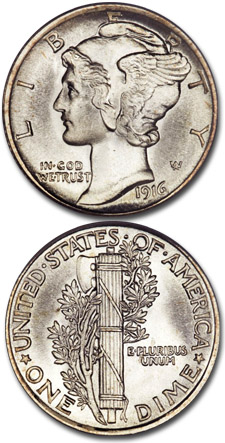The U.S. Mint is currently holding in its inventory nearly 9,000 2016-W Winged Liberty Head gold dimes, and the nation's coin producer has yet to announce plans for reselling the coins.
- Mercury Dimes (1916-1945) Silver Mercury Dimes were introduced by the United States Mint in 1916 and were struck annually until 1945 (with the exception of three years). The silver coins are also known as Winged Liberty Head Dimes which is probably a more accurate title even if most coin enthusiasts do not routinely use it. 1923 Mercury Dime.
- As a child, the winemaker loved and collected the Liberty dime - nicknamed the 'Mercury Head' - which now fittingly graces his flagship wine's bottle.
- With no overdates, no proofs, and well more than 300 million Mercury dimes struck, 1943 is a highly affordable date for aficionados of the Winged Liberty Head dime series. Common across virtually all grades, 1943 Mercury dimes pose few collecting challenges for numismatists, save for those who want ultra high-grade specimens with fully split.
The U.S. Mint offered the maximum authorization of 125,000 coins at noon Eastern Time April 21 at $205 per coin. At the household ordering limit of 10 coins, enough orders were placed to consume the entire maximum mintage of the tenth-ounce .9999 fine gold coins in less than an hour.
However, as of July 5, Mint records reflect 116,111 coins sold.
Connect with Coin World:
The gold dime marks the centennial anniversary of the Winged Liberty Head dime introduced in .900 fine silver in 1916.
If the coins sold out so quickly, why are there leftovers?
Mint State (MS65) FB - Full, Split Band Lines Full bands lines, often referred to as FB, signify a well struck Mercury Dime. There's three major bands wrapped around the column, and they must be 'split' and full to gain an FB designation. The Mercury dime, also known as the Mercury Head dime, is one of the most popular coins collected today. First minted in 1916, the Mercury dime replaced the Barber dime that had been in use since 1892. A competition was held to determine the design that would be used for the new dime. Playtech quantum roulette games.
In short, canceled orders and returns.
Like any other retail purchase, the initial U.S. Mint transaction is not always the final.

Within two weeks of the coin's sellout, after many were already shipped to the customers who ordered them, order cancellations began. The Mint canceled some orders because of expired credit cards or other Mint customer account problems.
Then, whether because of buyer's remorse or inability to quickly flip the coins for a sizeable profit, the number of returned coins began to rise. Also, some coins were returned because of damage to the coins or to the packaging. William hill big spin.
So what now?
U.S. Mint officials have been considering how the bureau will resell the unsold coins. Many collectors have been highly critical of the Mint's original decision to allow sales of 10 coins per household, instead of limiting sales to just one or two and allowing more collectors to acquire the coins at issue price.

Since pricing for the coins is based on the spot price of gold and a pricing grid the Mint has established, when the gold dimes are placed on sale a second time buyers may be paying a different price than the initial release price.
More gold 1916 centennial coins on the way
Mercury Head Dime Wine
Gold market fluctuations will also determine pricing for the 2016-W Standing Liberty gold quarter dollar and 2016-W Waking Liberty gold half dollar still to be released.
Mint officials have not announced whether the gold dimes may be offered in tandem with the initial sales of the gold Standing Liberty quarter dollars or at a separate time.
No information on release dates, mintages, or household ordering limits has been disclosed for the gold quarter dollars or half dollars.
The gold Standing Liberty quarter dollar, however, did make a surprise appearance at the Central States Numismatic Society convention earlier this spring. Pioneer bingo.
The Mercury Dime, also referred to as the Winged Liberty Head Dime, was introduced in 1916. The new design had been adopted as soon as the denomination was legally eligible to be changed and was selected through a public competition. The new series was more favorably received by the public and remains one of the most popular U.S. coin types to collect.
Reference


The design for the series was created by Adolph A Weinman, who would also design the popular Walking Liberty Half Dollar. The obverse of the dime features the head of Liberty, facing left. Her hair is pulled up under a winged cap, which gives the impression of the winged god Mercury. The inscriptions include “Liberty”, “In God We Trust”, and the date. The reverse of the coin features Roman fasces with an olive branch behind. The reverse inscriptions include “United States of America”, “E Pluribus Unum”, and “One Dime”
Mercury Dimes were produced from 1916 to 1945 with coins struck at the Philadelphia, Denver, and San Francisco Mints. While there are only a few dates which can be considered scarce, the popularity of the series does make it difficult to complete a full set, particularly in uncirculated condition. In circulated grades, the majority of the issues are easily obtained with the exception of the key date 1916-D, which carries a strong premium even in low grades.
This site will provide a basic history of the Mercury Dime along with information on the mintages and specifications of the coin. Additional details are provided for some of the scarce or more popular issues that are of greater interest to collectors.